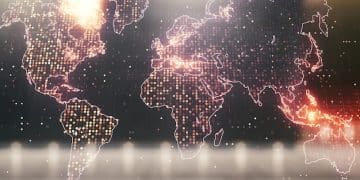Labor Market Trends: Bridging Skills Gaps & Workforce Shortages in 2025

The evolving landscape of Labor Market Trends: Navigating the Skills Gap and Workforce Shortages in 2025 demands proactive strategies from businesses and policymakers to address critical skill shortages and demographic shifts, ensuring a resilient and adaptable workforce for future economic stability.
As we approach 2025, the global workforce faces unprecedented shifts, largely driven by technological advancements, demographic changes, and evolving economic models. Understanding and adapting to these Labor Market Trends: Navigating the Skills Gap and Workforce Shortages in 2025 is not merely an option, but a strategic imperative for businesses and policymakers alike. This exploration delves into the core challenges and potential solutions shaping the employment landscape.
The Evolving Landscape of Work and Global Shifts
The world of work is in a constant state of flux, influenced by a myriad of global forces. Geopolitical tensions, climate change, and economic instability all play significant roles in shaping where, how, and why people work. This dynamic environment necessitates a forward-thinking approach to labor market planning and policy development.
Digital transformation, in particular, continues to redefine job roles and required competencies. Automation, artificial intelligence, and big data are not just buzzwords; they are integrated components of business operations, fundamentally altering the demand for human skills. As routine tasks become automated, the emphasis shifts towards abilities that machines cannot easily replicate.
Demographic Dynamics and Their Impact
Perhaps one of the most persistent and impactful trends is demographic change. Aging populations in many developed nations, coupled with declining birth rates, are leading to a shrinking traditional labor pool. This creates significant pressure on social welfare systems and exacerbates existing workforce shortages in key sectors. Conversely, some regions experience a youth bulge, presenting both opportunities and challenges for job creation and educational attainment.
- Aging Workforce: A growing proportion of older workers brings valuable experience but also raises questions about succession planning and skill transfer.
- Declining Birth Rates: Fewer young entrants into the workforce means future talent pipelines may be insufficient to meet demand.
- Migration Patterns: International migration plays a crucial role in redistributing labor, but it is often influenced by complex political and economic factors.
- Generational Shifts: Each generation brings unique expectations and values to the workplace, requiring flexible management and engagement strategies.
The implications of these demographic shifts are profound. Businesses must develop robust strategies for retaining older workers, attracting and integrating diverse talent, and investing in lifelong learning initiatives. Governments, too, face the challenge of designing immigration policies that address labor needs while promoting





